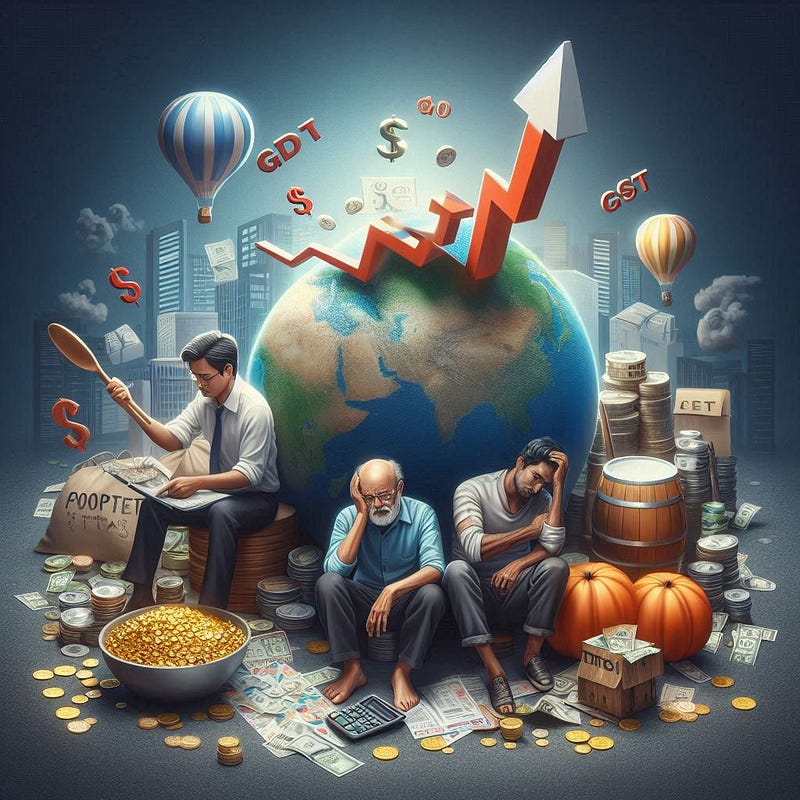How GDP, GST & Inflation numbers do not convey the reality?
For a developed economy like the US, Europe, or Japan — the GDP numbers & the tax collections would indicate how much they have advanced every quarter, every year.
But for a country like India — GDP, GST & Inflation data are just statistics. It cannot explain with certainty if we are progressing or regressing. Let us try to analyze why.
“GST Revenue collection for April 2022 highest ever at Rs 1.68 lakh crore” — read here
GDP PROJECTED TO GROW 8.0–8.5 PERCENT IN 2022–23 — read here
“The National Statistical Office (NSO), Ministry of Statistics and Programme Implementation (MoSPI) is releasing All India Consumer Price Index (CPI) at 7%” — read here

So as per the Press Information Bureau we have record GST collection, record GDP growth and lower inflation than advanced economies — but are we really doing better? The answer would be NO. That’s because the actual commerce happens in Semi-urban and rural India and these data are not measured. And the data which is collected now has a skew toward urban households & industries.
- People going for daily wages (not assured jobs)
- People going for support services like housemaids, auto drives, cab drivers, plumbers, electricians (non assured jobs)
- People working on a monthly salary with big companies (assured jobs)
- People working as consultants, doctors, dentists, architects (high income assured jobs)
- Small kirana shops supplying daily necessities like grocery, toiletries, food & grains, textile, hardwares (listed shops)
- Road side vendors selling items like clothes, towels, footwear, icecream, bakery, vegetables, fruits etc (non listed shops)
- Supermarkets, hypermarkets & shopping malls offering almost all essentials (listed shops with strong income)
Let’s try to dig deep into this. Imagine a small town that has
This list is not final, but for the discussion here this will suffice. Now broadly we can classify the demographic into
- People who do not have an assured job or income will not be able to pay Income Tax, thats why 95% of Indian population are nontax payers — read here. Even though they are not taxpayers — they still consume food, clothing, shelter & transportation. It’s just that nobody knows how much.
- Shops that are too small, roadside vendors, rikshaw drivers, plumbers, electricians, maids, milkmen do not pay GST — although the Govt. does not have official data on how much of services have slipped the GST net, I assume it’s much more than the collections.
- These 2 segments are hardly surveyed or sampled for GDP or inflation calculations — read here
We have now set the prerequisite on what’s happening in a town, let’s go to the final step which shows the anomaly. Let’s assume the kirana shops + roadside vendors + supermarkets did a business of 1000 units in a particular month (300 + 100 + 600).
- 300 units of business came from kirana shops
- 100 units of business came from roadside vendors
- 600 units of business from supermarkets
Now under the Govt. radar only 600 units of business came under the GST, GDP, Inflation screener. (i.e. business from the supermarkets which are GST registered).
Govt. pushes its reform to digitize India and thereby empower more people to consume & spend via digital money transactions, UPI, credit/debit cards etc. Naturally, the beneficiary would be the supermarkets as their systems are scalable and flexible. So in the adjacent month even if the town spends only 900 units wherein
- 150 units from kirana shops
- 50 units from roadside vendors
- 700 units from supermarkets
Technically the govt sees there is a 16.6% increase in the business activity as the no. of units has gone up from 600 to 700 — so they believe India is growing further. But the reality is that the town has spent fewer units 900 instead of 1000 ie a 10% drop in consumption. Many kirana shops & roadside vendors are out of business due to lack of infrastructure.
So in reality even if the country is nose-diving, the data received at the Govt.’s desk is that of progress — so they are getting blindfolded that their reforms are working. What they should actually do is onboard the small merchants, self-employed services people on a common platform first — gather the data and then push for reforms. Otherwise what will happen is — the big will keep getting bigger & the small smaller.
This is the reason why there is a widening spread between the rich & poor. The rich already have the means to exploit the reforms & the poor are unaccounted for.
The same can be applied to the services sector, self employed sector too.

https://amzn.to/43Rhrqthttps://amzn.to/43Rhrqthttps://amzn.to/43Rhrqt
